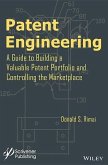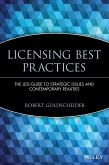This book provides a strategic framework for cost efficient engineering of market moving patent portfolios by organizing patent engineering efforts around the problems that innovators solve for their customers and not the technologies developed to solve these problems. Patents are a vital asset in the modern business world. They allow patent holders to introduce new products in to a market while deterring other market players from simply copying innovative features without making comparable investments in research and development. In years past, a few patents may have provided adequate protection. That is no longer the case. In today's world, it is critical that innovative companies protect the features of their products that give them a competitive advantage with a family or portfolio of patents that are strategically generated to protect the market position of the patent holder. A patent portfolio that deters competitors from introducing competitive products in a timely manner can be worth billions of dollars. Anything less than this is an expensive and possibly fatal distraction. This book provides a strategic framework for cost efficient engineering of patent portfolios that protect your investments in research and development and that extend the market advantages that these investments provide. The book illustrates the use of the problem centric framework to enable the efficient creation of individual patents and patent portfolios that have significant value in and by themselves and allow a company to control its product market. It also introduces the concept of a patent engineer whose role it is to organize input from legal, business and technical communities and organize portfolios and patents using the problem centric framework. Audience This book is primarily aimed at entrepreneurs, industrial engineers, scientists, and company managers. This book is especially valuable for start-up high tech businesses that need to protect their intellectual property, as well as more established companies seeking to enhance the value of their patent portfolios and be able to more effectively compete in the marketplace. It will also be of value to patent law firms, investment companies and not-for-profit organizations such as universities as this book shows how to extract profits from the intellectual property.








